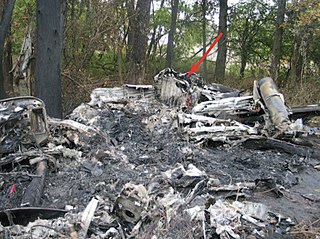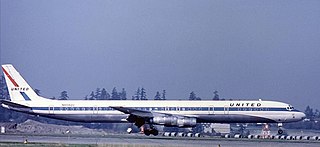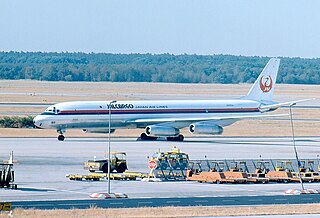Related Research Articles

Westchester County Airport is a county-owned airport in Westchester County, New York, United States, three miles (6 km) northeast of downtown White Plains, with territory in the towns of North Castle and Harrison, New York, and the village of Rye Brook, New York. It is sometimes referred to as the White Plains Airport and is so identified by the Official Airline Guide (OAG).
Continental Express was the brand name used by a number of independently owned regional airlines providing commuter airliner and regional jet feeder service under agreement with Continental Airlines. In 2010 at the time of Continental's merger with United Airlines, two carriers were operating using the Continental Express brand name:

Santa Barbara Municipal Airport is 7 miles west of downtown Santa Barbara, California, United States. The airfield covers 948 acres (384 ha) of land and has three runways.

Corporate Airlines Flight 5966 was a scheduled passenger flight from St. Louis, Missouri to Kirksville, Missouri. On October 19, 2004, the Jetstream 32 aircraft operating the flight crashed on approach to Kirksville Regional Airport as a result of pilot error, killing 13 of the 15 people aboard.

Presque Isle International Airport, formally Northern Maine Regional Airport at Presque Isle, is a mile northwest of Presque Isle, in Aroostook County, Maine, United States. It serves the residents of Presque Isle and a vast area of northern Maine and northwestern New Brunswick. Airline flights to Newark Liberty International Airport are subsidized by the federal government's Essential Air Service program at a cost of $3,892,174.

Fort Worth Meacham International Airport is a general aviation airport located near the intersection of Interstate 820 and Business U.S. Highway 287 in Fort Worth, Texas, United States. It is named after former Fort Worth Mayor Henry C. Meacham. The airport covers 745 acres.
Ameriflight LLC is an American cargo airline with headquarters at the Dallas/Fort Worth International Airport. It is the largest United States FAA Part 135 cargo carrier, operating scheduled and contract cargo services from 19 bases to destinations in 250 cities across 43 US states as well as in Canada, Mexico, the Caribbean, and South America. Ameriflight serves major financial institutions, freight forwarders, laboratories, and overnight couriers in the US, and provides feeder services for overnight express carriers nationwide and internationally. Ameriflight averages 525 daily departures with over 100,000 combined flight hours annually and a 99.5% on-time performance. Ameriflight employs over 700 people.

United Airlines Flight 173 was a scheduled flight from John F. Kennedy International Airport in New York City to Portland International Airport in Portland, Oregon, with a scheduled stop in Denver, Colorado. On December 28, 1978, the aircraft flying this route ran out of fuel while troubleshooting a landing gear problem and crashed in a suburban Portland neighborhood near NE 157th Avenue and East Burnside Street, killing 10 people on board.

Continental Express Flight 2574 was a scheduled domestic passenger airline flight operated by Britt Airways from Laredo International Airport in Laredo, Texas to Houston Intercontinental Airport (IAH) in Houston, Texas. On September 11, 1991, the Embraer EMB 120 Brasilia turboprop, registered N33701, crashed while initiating its landing sequence, killing all 14 people on board. The aircraft wreckage hit an area near Eagle Lake, Texas, approximately 65 miles (105 km) west-southwest of the airport.

Air New Orleans was an airline based in Birmingham, Alabama that was conceived as a commuter air carrier to provide scheduled passenger service to cities throughout the Southeastern United States from Texas to Florida. The airline was founded in 1981 in Panama City, Florida and operated scheduled passenger service between 1981 and 1988.

Golden West Airlines Flight 261, a de Havilland Canada DHC-6 Twin Otter, collided with a Cessna 150 (N11421), owned by CessnAir Aviation, Inc., near Whittier, California. The accident occurred on January 9, 1975, at approximately 4:07 p.m. PST, while the Sun was just 9 degrees above the western horizon, directly into the eyes of the pilots of GW flight 261.

In aviation, a preflight checklist is a list of tasks that should be performed by pilots and aircrew prior to takeoff. Its purpose is to improve flight safety by ensuring that no important tasks are forgotten. Failure to correctly conduct a preflight check using a checklist is a major contributing factor to aircraft accidents.

On April 9, 1990, Atlantic Southeast Airlines Flight 2254, a scheduled passenger flight from Muscle Shoals, Alabama, to Gadsden, Alabama, to Atlanta, Georgia, was involved in a mid-air collision with a Cessna 172 over Gadsden. The collision resulted in the death of the pilot and passenger of the Cessna 172.

The British Aerospace Jetstream is a small twin turboprop airliner, with a pressurised fuselage, developed as the Jetstream 31 from the earlier Handley Page Jetstream. A larger version of the Jetstream was also manufactured, the British Aerospace Jetstream 41.

On September 23, 1985, Henson Airlines Flight 1517 crashed in Grottoes, Virginia, while on approach to the Shenandoah Valley Regional Airport. The two pilots and twelve passengers were killed.

Downeast Airlines Flight 46 was a scheduled airline service in the United States from Boston's Logan International Airport to Rockland, Maine operated by Downeast Airlines. On May 30, 1979, the de Havilland Canada DHC-6 Twin Otter operating the flight crashed during a nonprecision approach to Rockland's Knox County Regional Airport. All but one of the 18 people on board were killed. The cause of the accident was controlled flight into terrain (CFIT) after the failure of the flight crew to stop the aircraft's descent below the minimum descent altitude for the non-precision approach at Knox County airport. The investigation into the accident looked into the airline's corporate culture as a contributing factor to the crash; this was the first time an investigation took this approach to an air crash.

Delta Air Lines Flight 723 was a flight operated by a McDonnell Douglas DC-9 twin-engine jetliner, operating as a scheduled domestic passenger flight from Burlington, Vermont, to Logan International Airport in Boston, Massachusetts, with an intermediate stop in Manchester, New Hampshire. On July 31, 1973, at 11:08 a.m., while on an instrument landing system (ILS) instrument approach into Logan in low clouds and fog, the aircraft descended below the glidepath, struck a seawall, and crashed. All 89 of the occupants aboard were killed, including an initial survivor who died more than 4 months after the crash.

Japan Air Lines Cargo Flight 1045 was a charter flight on January 13, 1977, from Grant County, Washington, to Tokyo, Japan, with a stopover in Anchorage, Alaska. The flight crashed during the initial climb shortly after takeoff from Anchorage, in part because the captain, Hugh L. Marsh, was intoxicated as shown by a blood alcohol level of 0.29; the co-pilot and the other crew were not impaired. All of those on board, including three flight crew members, were killed in the crash.

Scandinavian Airlines System Flight 901, was a scheduled international flight operated by the Scandinavian Airlines System, that overran the runway at its destination at John F. Kennedy International Airport on February 28, 1984. The flight, using a McDonnell Douglas DC-10, originated at Stockholm Arlanda Airport, Sweden, before a stopover at Oslo Airport, Gardermoen, Norway. All 177 passengers and crew members on board survived, although 12 were injured. The runway overshoot was due to the crew's failure to monitor their airspeed and overreliance on the aircraft's autothrottle.

Ryan International Airlines Flight 590 was a cargo flight carrying mail for the United States Postal Service from Greater Buffalo International Airport (BUF) in Buffalo, New York, to Indianapolis International Airport (IND) in Indiana, with a stopover at Cleveland Hopkins International Airport (CLE) in Cleveland, Ohio. On February 17, 1991, the McDonnell Douglas DC-9-15RC operating the flight crashed on takeoff from Cleveland during icing conditions. Both pilots, the aircraft's only occupants, were killed. The National Transportation Safety Board (NTSB) determined that the causes of the crash were the flight crew failing to deice their aircraft, and the inexperience of the Federal Aviation Administration (FAA), McDonnell Douglas, and Ryan International Airlines with icing condition on DC-9-10 aircraft.
References
- Hall, Jim. "Chairman of the National Transportation Safety Board before the Symposium on Corporate Culture and Transportation Safety in Washington, D.C.", Speech April 24, 1997
- Maine Atlantic Aviation. "MAA Acquires Downeast Air" [ permanent dead link ], Press Release June 12, 2007
- Nance, John J. (1986). Blind Trust, First Edition. William Morrow and Company, Inc. ISBN 0-688-05360-2
- National Transportation Safety Board (NTSB). (May 12, 1980). Aircraft Accident Report NTSB-AAR-80-5.